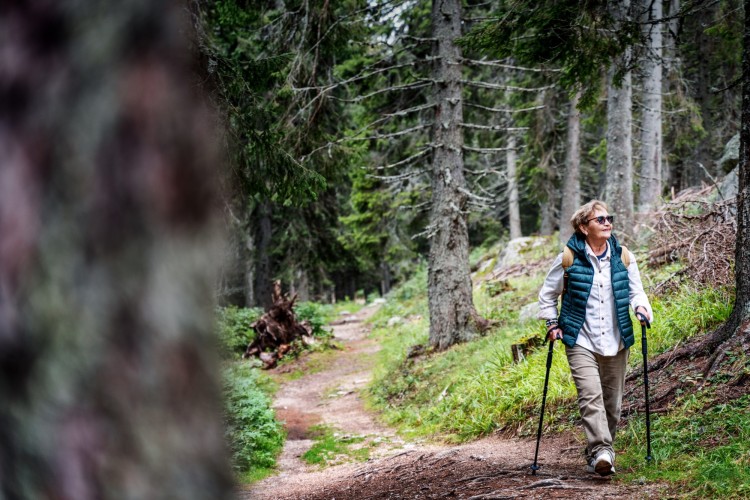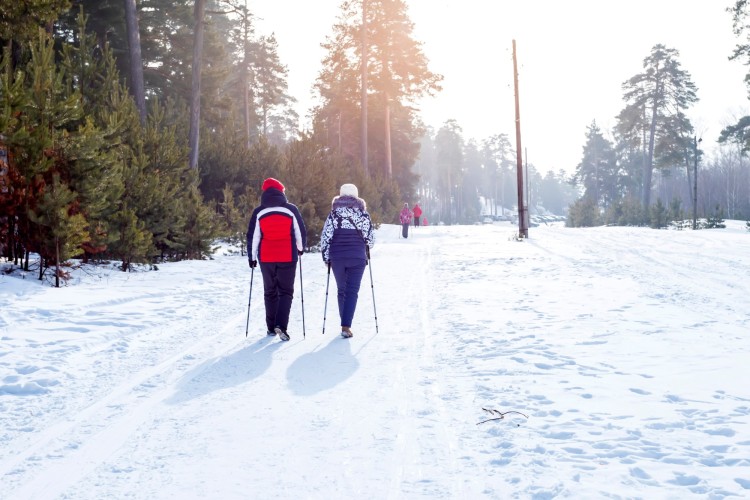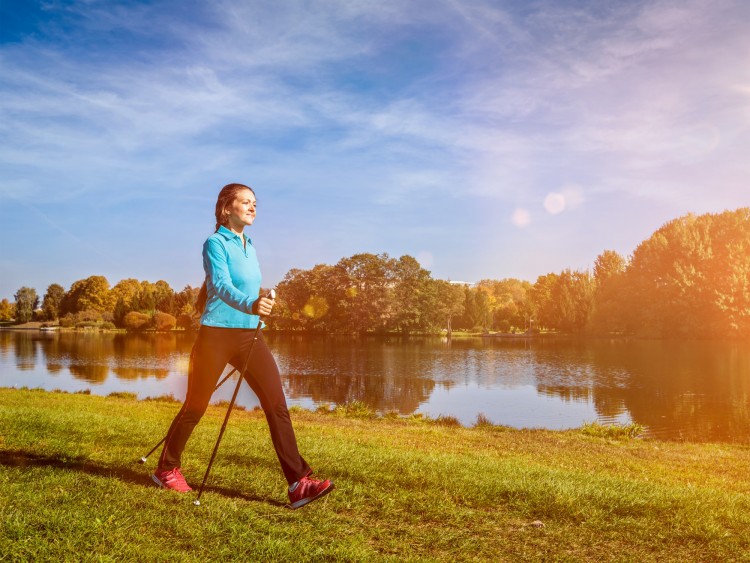Nordic walking offers widespread benefits for people of all ages and abilities. However, fitness buffs and serious athletes can use Nordic walking for full-body training that can be done anywhere.
“Nordic walking is your gym to go – almost any place, any time, and it’s free,” says Suzanne Nottingham, Nordic Walking Now owner and lead author of Nordic Walking for Total Fitness (Human Kinetics, December 2009).
Nottingham continues, “Nordic walkers combine poles and physical strength to move their body weight forward and over the ground. This is how it provides both a cardio and strength workout simultaneously. You can create even more resistance by nailing the sweet spot of the tips every time.”

Walking with Nordic poles offers a portable workout that improves nine key performance areas. Photo: Olezzo via Shutterstock
Some of the links in this article may contain affiliate links. When you purchase using these links, part of the proceeds go to Snowshoe Mag. Additionally, as Amazon Associates, we earn from qualifying purchases. Please see our disclosure for more details.
Benefits of Nordic Walking To Performance
In Nordic Walking for Total Fitness, Nottingham discusses how walking with Nordic poles offers a portable workout that improves nine key performance areas.
1. Cardiorespiratory stamina
“Aerobic and anaerobic conditioning is the essence of Nordic walking fitness,” Nottingham explains. “It is an ideal activity for cardiorespiratory fitness because it can be performed at any intensity. Those who wish to compete at a higher level have options for intensive training.”
Read More: Snowshoeing for Improved Fitness with Nordic Walking Poles
2. Muscular endurance
“With practice, skilled Nordic walkers acquire a more athletic gait that combines simultaneous physical reactions with a faster pace and speed,” Nottingham says. “Muscular endurance allows you to settle into a comfortable yet productive pace. Endurance also creates a greater mass of lean muscle because it is sometimes facilitated by an aerobic pace.”
Read More: Build and Maintain Snowshoeing Endurance All Year Long
3. Balance
Poles challenge the upper and lower body simultaneously, resulting in better balance, says Nottingham. “Nordic walking challenges you to achieve more dynamic balance because you are working the upper body to move forward while recovering small imbalances in the feet, ankles, legs, and pelvis,” she explains.
Read More: Exercises To Improve Balance: One Foot at a Time
4. Enhanced range of motion
The pole swing in Nordic walking enhances the opposite arm’s swing, compared with walking normally. “The increased range of motion allows you to literally cover more ground,” notes Nottingham.
Read More: 10 Reasons to Use Poles While Snowshoeing

Nordic walking poles can be used all year round to improve agility and coordination. Photo: Sergei Kochetov via Shutterstock
5. Agility
Agility and balance work together against stimuli that throw the body off its axis. Various fun agility drills relate to Nordic walking, according to Nottingham. Some involve the creative use of poles; others utilize the natural environment. You can find several variations in Nordic Walking for Total Fitness.
Read More: Training Tips for Snowshoe Racing: Triathlete Brad Zoller Hits the Snow
6. Coordination
“Your Nordic walking skills will be efficient when your movements are so subtle and well memorized that your brain is able to communicate instructions for movement with ease, developing physical and mental sequential reactions without wasting energy,” Nottingham comments.
Read More: 3 Leg Exercises Every Snowshoer Can Do Without Weights
7. Increased efficiency of movement
Nordic walkers often comment that their practice helps them walk with greater grace and ease, even without poles.
8. Visual skills
The stability the pole tips provide allows Nordic walkers to focus their vision ahead instead of down at the ground, says Nottingham. The visual skills gained during Nordic walking, in turn, assist postural integrity by helping balance one’s head weight, improving poor posture, and eliminating back strain.
Read More: Back Exercises for Snowshoers

Improvements in visual skills, strength, and power are two areas where Nordic walking can offer increased performance. Photo: Dmitry Rukhlenko
9. Strength and power
“Nordic walking requires full-body effort to support the demands of repetitive motion and endurance,” Nottingham explains. “If performed safely, it results in muscle balance and back health.”
Nordic Walking for Total Fitness offers a range of programs for cardio health, full-body conditioning, and sport-specific cross-training. With 115 full-color photos, Nottingham and coauthor Alexandra Jurasin provide a guide for Nordic walking, including equipment, techniques, and supplemental conditioning for maximum fitness and enjoyment.
For more information on Nordic Walking for Total Fitness or other fitness resources, visit www.HumanKinetics.com or call 800-747-4457.
This article was first published on September 15, 2009, and was most recently updated on June 29, 2023.
Read Next: Nordic Walking for Warm Weather Training: A Book Review





